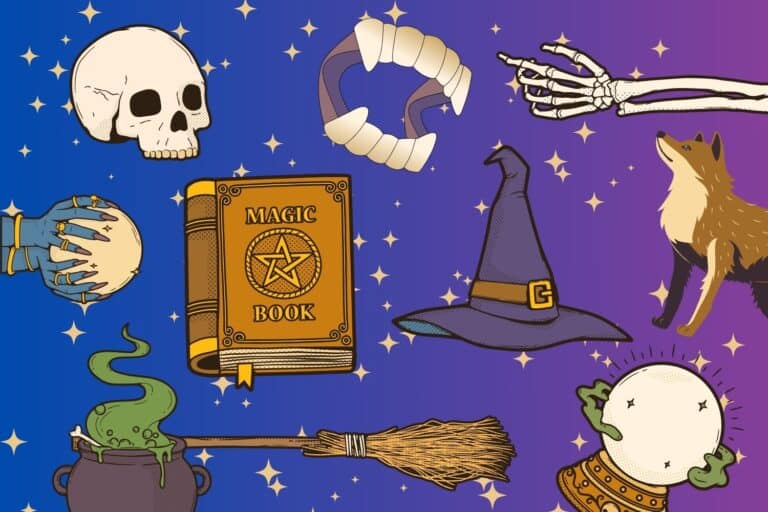
Gather ‘round, Unpacked readers! Halloween is here and with it brings the spooky and scary creatures of folklore. But the most frightening element of this holiday season is the rampant historical antisemitism that spawned many of these famous characters. From goblins to witches, Jewish lore and stereotypes unite this crew of creepy and kooky mythical creatures. Read on below if you dare!
Werewolves
On “30 Rock,” Tracy Morgan famously sang “Werewolf Bar Mitzvah.” But did you know that Jewish werewolves are common? While they aren’t having Bar Mitzvahs, Jewish authors and commentators have historically used this term to describe other Jews.
Werewolves initially appeared in “The Epic of Gilgamesh” and in Greek mythology, as well as in Nordic folklore. Werewolves are notoriously difficult to spot; by day, they wander around as humans but by night and the power of the full moon, they transform into wolves on the hunt for people. The connection between Jews and werewolves has remained pervasive because like the shapeshifters, the Jewish people were also outsiders for following a lunar calendar, and disappearing for Jewish holidays that begin at sundown.
Historically, like witches, there were werewolf trials, beginning in the 1400s in Europe, with even the pope presiding over them.
Read more: ‘Spooktacularly’ good Jewish ghost stories
In his interpretation of the Torah, Medieval Rabbi Ephraim ben Shimshon described Jacob’s son Benjamin as a werewolf, writing, “There is a type of wolf that is called loup-garou (werewolf), which is a person that changes into a wolf. When it changes into a wolf, his feet emerge from between his shoulders. So too with Benjamin—’he dwells between the shoulders’ (Deuteronomy 33:12).” The rabbi famously wrote that the fear for Benjamin was not that he ravenously killed, but that he would shift in front of others and be harmed as a result
Russian writer H. Leyvick, playwright of “The Golem,” wrote his 1920 Yiddish poem “The Wolf” describing a rabbi who, as the lone survivor in the aftermath of his destroyed town, transforms into a werewolf. When others return to rebuild, the werewolf rabbi attacks the townspeople, eventually dying at their hands “For on the floor, tortured, in a river of blood / Lay not a wolf but a Jew in a rabbinical fur hat,” Leyvick writes. The poem is presumed to be a metaphor for the rampant Russian pogroms of the time, and the idea that Jews are no better than their oppressors, fighting each other to survive instead of turning their anger towards their attackers.
Other media, like the film “An American Werewolf in London” (1981), follow Jewish werewolves similar to Leyvick’s protagonist. After being attacked by a werewolf in London, American grad student David Kessler wakes up in a hospital and learns he now suffers the same fate as his attacker. In the hospital, the nurses are quick to point out that he is Jewish, which is seemingly more prominent than his new affliction as a werewolf; In his dreams, he and his family are attacked by Nazi zombie-werewolves.
Years earlier, the film “The Wolf Man” (1941), was written by Curt Siodmak, a Jewish screenwriter who fled Poland during the 1930s to avoid persecution by the Nazis. In the movie, Lawrence Talbot returns home to London from the U.S., and he is bitten by a werewolf, fated to become a beast at the full moon. This film also emphasizes that feeling of otherness; Lawrence’s pentagram signifying he is a werewolf could directly be translated as the Star of David.
Goblins
Initially called “hobgoblins” after the “invaders” of Scandinavia and the British Isles from French folktales, goblins are small but sinister creatures, who are members of a specific fairy species. Their depictions vary, and are viewed as sprites in parts of Europe who are seemingly friendly but evil at heart.
There’s a scene in “Harry Potter and the Sorcerer’s Stone” where Harry Potter goes to Gringotts Bank in Diagon Alley. Upon seeing the worker’s inside, he asks Hagrid what those “things” are.

“They’re goblins, Harry. Clever as they come but not the most friendly of beasts,” Hagrid tells him.
Those “beasts,” with their long noses, sharp teeth, short bodies, long fingers, and pointy ears have been widely blasted as antisemitic. They bear an almost uncanny resemblance to longstanding caricatures of Jewish people and antisemitic stereotypes about Jewish people controlling the banks.
Read more: Daniel Radcliffe’s Jewish identity
In a podcast episode of “The Problem with Jon Stewart,” Stewart is critical of J.K. Rowling’s choice, comparing the goblins’ portrayal to an image in the notoriously antisemitic publication, “The Protocols of the Elders of Zion”.
Jewish people are continuously portrayed as scary looking, appearing larger than life, with big noses and a proximity to money. In old wood carvings and art, goblins mimic older antisemitic tropes of what a Jewish person looks like.

The UK Campaign Against Antisemitism described how Rowling’s goblins are a product of these historical depictions: “The mythological associations have become so ingrained in the Western mind that their provenance no longer registers with creators or consumers. Those who continue to use such representation are often not thinking of Jews at all, but simply of how readers or viewers will imagine goblins to look, which is a testament more to centuries of Christendom’s antisemitism than it is to malice by contemporary artists.”
In the “The Lord of the Rings” franchise, J.R.R Tolkien uses dwarves, another mythological creature as an allegory for Jewish people. He describes them as being “at once native and alien in their habitations” with language that was “Semitic, obviously, constructed to be Semitic.” In more than just appearance, the dwarves are depicted to be greedy and whiny, character stereotypes of Jews. Though Tolkien’s Gimli ends up being a hero in the end, his characterization is a result of numerous years of stereotypes.
Vampires
Vampires use their sharp fangs to drink blood and kill humans, turning them into other vampires. The myth of the vampire was widely believed during the Middle Ages, when the bubonic plague caused people to have bleeding mouth lesions. Diseases like porphyria were relieved by ingesting blood temporarily, which fed the vampire myth; when exposed to sunlight, the skin of those afflicted would have blisters, another so-called symptom of vampirism.
For centuries, Jewish people have been depicted as scary vampires, drinking blood from unsuspecting Christians and corrupting them.

The origin of this imagery comes from blood libel conspiracy theories that claim that Jews pray on gentile strangers, drinking their blood as a means for youth and freedom, and threatening the Catholic Church by working with the devil. The origins of these myths date back to 1144 England, when a young boy named William went missing and a monk claimed Jews had taken him and crucified him for a ritual sacrifice. In May 1171 in France, a 40-person Jewish community was burned alive over the belief they killed a child for a ritual murder. These accusations were all unfounded, but as time went on, these theories about blood-sucking Jews have persisted.
In Jewish folklore there actually are Jewish-female vampires. Known as estries, these creatures first appeared in the sefer hasidim, a medieval book written by northern Italian Kabbalist Judah ben Samuel of Regensburg describing the life of pious Jews, including morals and tales.
Estries are shape-shifters who only pray on Jewish people and are theorized to be the daughters of Lilith. There is also an alukah (translated to “horse-leech” in English), the first Jewish vampire and demon, related to Lilith; in proverbs 30, the ravenous alukah is described as “hav[ing] two daughters, ‘Give!’ and ‘Give!’ Three things are insatiable; Four never say, ‘Enough!’”
Many interpretations of Dracula can be viewed through a Jewish lens. Some scholars say that in Bram Stoker’s novel, Dracula — the Eastern European outsider — is a stand-in for the threat of Jewish immigration to the U.K. that was happening during the time. In the 1922 silent film “Nosferatu,” Count Orlock is seen as a threat to the values of Christians and a sexual predator; his outsiderness reflects the values and antisemitic views of Germans at the time. The film villain is also spotted wearing a six-pointed pendant around his neck.
Witches
Witches possess powers and can use spells and spirits to perform dark magic. They work for the devil and were first seen in Book One of Samuel when the Witches of Endor summoned Samuel. Most notably, various women and girls were accused of being witches during the Salem witch trials in 1692, and women were hunted as witches throughout the Middle Ages in Europe.
Unfortunately, witches have an antisemitic history. In depictions, their hooked noses and claws are associated with the blood libel. Christians believed Jewish men experienced menstruation and had impure blood, needing gentile blood for healing. Thus, they were servants of the devil. Discourse in the 15th and 16th centuries transferred these ideas to all women, the evil daughters of Eve that menstruate.

In stories like Grimm’s “Hansel and Gretel” or Roald Dahl’s “The Witches,” these spellcasters target children, and eat them. These theories have long been associated with Jews. Art like Hans Baldung’s “The Witches,” a piece with fake Hebrew lettering depicts naked witches as Jewish and anti-Christian, committing blood libel and eating flesh.
In the Torah, witches have historically been vilified, having been associated with adultery, though there have also been famous witches. Ahab, the king of Israel, was married to Queen Jezebel, an idolatrous but magical witch; she is described by Jehu as “carr[ying] on her countless whoredoms and sorceries,” (II Kings 9:22).
Women are primarily associated with witchcraft, with Lilith being said to have transformed herself into a witch, although some rabbis are said to have used magical spells and potions.
Today, there are Jewish people attempting to change the bad reputation behind witches. “Jewitches” are trying to bring to light old Jewish practices and Jewish magic, utilizing the kabbalah to bring healing. Kabbalah has historically been intertwined with what some may call magic, and these Jewitches are embracing centuries of folklore and spirituality into their Judaism.
